#277 Latest Comet Hyakutake images: March 22, 1996

“People the world over are preparing to witness the closest approach of the brightest comet of the past twenty years. Comet Hyakutake, discovered just two months ago, will pass nearest the Earth Monday morning. All during the coming week, Comet Hyakutake will be visible in the northern sky as an unusual extended fuzzy patch. To see the comet is not difficult - just go outside and look up - no telescope is required! The comet's location in the sky during late March is charted above. The horizon is drawn for about 8 pm in your local time. By about 11 pm, Comet Hyakutake will be high in the sky and well placed for viewing. Although Comet Hyakutake is whizzing past the Earth at a blistering speed of almost 100,000 miles per hour, and it is practically streaking across the sky by astronomical standards, it will appear to move only a few degrees on any given night. Each night this weekend and in the coming week, the comet will be visible. Please don't miss this rare and exciting astronomical event! Latest Comet Hyakutake images: Crni Vrh Observatory, Slovenia, Fayetteville Observer-Times"
Copyright: Izzy's
Skylog
#278 Latest Comet Hyakutake images: March 23, 1996

“The above false-color picture of Comet Hyakutake taken just two days ago shows its rapidly developing tail. The comet now has a substantial coma with a bright center, lending it a dramatic eye-like appearance. This is not Comet Hyakutake's first visit to the inner Solar System. Recent orbital determinations clearly show Comet Hyakutake's was here before, although the previous approach is estimated to be about 8600 years ago - during the epoch of the first recorded human cities. Were this the comet's first trip to the inner Solar System, it probably would not appear as bright as it does now - first time comets typically do not shed as much luminous gas as veterans. Before making any approach to the inner Solar System, Comet Hyakutake was dormant in the Oort cloud of the outer Solar System for a few billion years, along with hundreds of thousands of similar comets. Comet Hyakutake is predicted to become the brightest comet since Comet West in 1976, which rivaled the brightest stars in the sky. Tonight, Comet Hyakutake can be seen best from about 10 pm near the Big Dipper's handle. Latest Comet Hyakutake images: Crni Vrh Observatory, Slovenia, Fayetteville Observer-Times"
Copyright: Herman MikuzCrni Vrh Observatory
#279 Latest Comet Hyakutake images: March 24, 1996
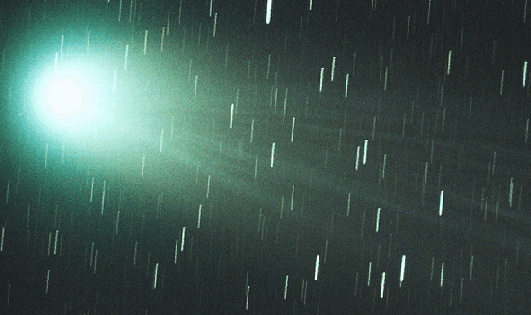
“The above true color image of Comet Hyakutake was taken the night of March 21/22. Tonight, Comet Hyakutake will make its nearest approach to Earth, closing to a mere 10 million miles as it passes over the planet's Northern Hemisphere. From dark sky areas, it's tail may be seen to cover about 20 degrees on the sky (40 times the apparent diameter of the full moon) corresponding to well over 3 million miles. at the distance of the comet. The word comet, referring to the tail, derives from the Greek "aster kometes", meaning long-haired star - and the hair of comet Hyakutake continues to grow as it nears the Sun! The tail grows as the sun heats and sublimates (changes directly from solid to gas) the material on the icy surface of the comet nucleus, sending jets of gas and dust into space. The material is swept back by the solar wind, so comet tails usually point away from the sun rather than simply trailing along behind in the comets' orbit. Some predict the tail will grow over the next few days to nearly 50 degrees. For the rest of March and most of April Comet Hyakutake will be visible to Northern viewers (weather permitting). The tail will be most visible from dark sky areas. Moonlit skies will tend to washout the comet as the April 3rd full moon approaches - however, on April 3rd, there will be a lunar eclipse! Latest Comet Hyakutake images: Crni Vrh Observatory, Slovenia, Fayetteville Observer-Times"
Copyright: Herman MikuzCrni Vrh
Observatory
#280 Latest Comet Hyakutake images: March 25, 1996
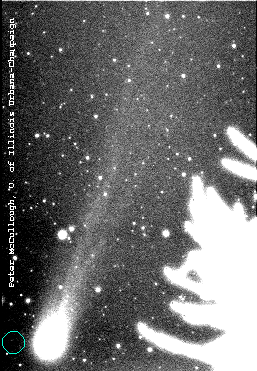
“This picture of Comet Hyakutake taken the night of March 21/22 in Illinois, USA shows the enormous tail that has already developed. The silhouette on the right is a foreground tree, and the superposed green circle on the left shows the size of the full moon. Today Comet Hyakutake makes its closest approach to the Earth. As the comet moves into the inner Solar System, it will pass the Earth at about 40 times the distance of our Moon. This is not the closest a comet has ever come, though. As recently as 1983 Comet IRAS-Araki-Alcock came three times closer than Hyakutake, and in 1770 Comet Lexell got yet twice closer than that! Asteroids - usually less massive than comets - frequently whiz by inside the Moon's orbit, with four doing so far in this decade. In the distant past, asteroids have even struck the Earth. Comet Hyakutake is much brighter now than Comet IRAS-Araki-Alcock ever got, and in fact is the brightest since Comet West in 1976. Comet Hyakutake will be easily visible all week. Latest Comet Hyakutake images: JPL, Crni Vrh Observatory, Slovenia, Fayetteville Observer-Times, NASA's Night of the Comet"
Copyright: U. Illinois Urbana-Champaign
McCollough's
MPEG
Movie of Comet Hyakutake taken March 23
#281 Latest Comet Hyakutake images: March 26, 1996
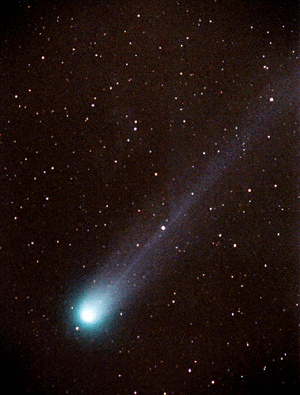
“The tail of comet Hyakutake, visible in this recent color image, is composed of dust and gas driven off the icy comet nucleus by the Sun's heat and blown away by the solar wind. Bathed in solar ultraviolet light, the gas molecules break down and are excited, producing a characteristic glow. This glow is responsible for visible light from the tail and astronomers using spectroscopes can identify the compounds involved. The close passage of Hyakutake presents an excellent chance to use this technique to explore the composition of its tail. Typical comet gas tail constituents are simple combinations of hydrogen, carbon, nitrogen, and oxygen - for example, H20 (water), CO (carbon monoxide), and CN (cyanogen) are common. In fact, the poisonous CO and CN compounds were seen in the spectrum of Halley's comet during its 1910 apparition. This caused some public concern at the time as the Earth was expected to pass through Halley's tail! However, stretching for millions of miles, comet tails are extremely thin and tenuous and don't pose a danger to the Earth's atmosphere. Latest Comet Hyakutake images: JPL, Crni Vrh Observatory, Slovenia, Fayetteville Observer-Times, NASA's Night of the Comet"
Copyright: Public domain
#282 Latest Comet Hyakutake images: March 27, 1996
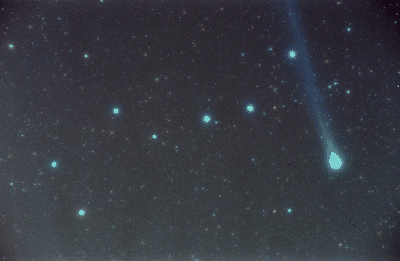
“The above true-color photo taken March 25th shows Comet Hyakutake passing below the stars of the Big Dipper. Many astronomy enthusiasts delight in helping people in their local community see the comet. Both Jerry Bonnell and I (RJN) from APOD have been so inclined - both now and when Comet Halley came by in 1986. During these sessions, many good questions are asked and occasionally a humorous situation will arise. One was with a little girl. She waited so patiently for her turn to look through the telescope, hardly able to contain her excitement. Finally her turn came. "Do you see the comet?" I asked. "Wow, wow, WOW!" She beamed. "You see it?" "No." One little boy seemed particularly bent on destruction. "This telescope looks like a big gun," he volunteered. "In some ways, it's even more powerful than a gun," I replied, hoping to challenge his imagination. "Really?" he countered. "Can we shoot down the comet?" "How expensive is the telescope?" is a fairly common question. But one time a real business-person showed up and, possibly feeling particularly affluent, asked "How much is the comet?" Latest Comet Hyakutake images: JPL, Crni Vrh Observatory, Slovenia, Fayetteville Observer-Times, NASA's Night of the Comet"
Copyright: Fayetteville Publishing Co.
#283 Latest Comet Hyakutake images: March 28, 1996
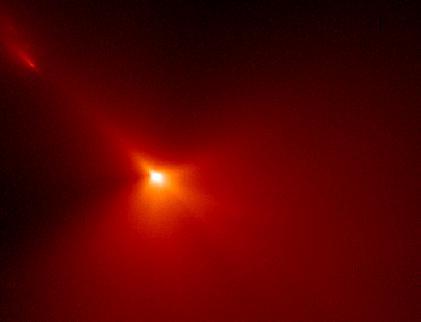
“NASA's Hubble Space Telescope captured this image of the near-nuclear region of Comet Hyakutake on March 25 as the comet approached within 9.3 million miles of the Earth. It covers a relatively "small" 2,000 mile wide area with the sunward direction toward the lower right (tailward is upper left). The image shows large amounts of dust jetting from the sunward side of the nucleus as the sun heats the surface of this dirty "orbiting iceberg". Pressure from sunlight eventually pushes the dust tailward and as the dust production increases, the already visually impressive tail will grow even brighter! The actual size of the nucleus is uncertain but is estimated to be 5-10 miles, similar to Comet Halley. As seen here, the brightest point is probably the tip of the strongest dust jet rather than the nucleus itself. A dramatic dust jet feature also appears to arise from the nightside but its true angle to our line of sight is difficult to judge. Some large fragments which have broken away from the comet nucleus are visible in the upper left of the image, producing dust tails of their own. Comet dust may represent primordial material from the formation of the solar system and NASA has plans for a comet dust sample return mission. Latest Comet Hyakutake images: JPL, Crni Vrh Observatory, Slovenia, Fayetteville Observer-Times, NASA's Night of the Comet"
Copyright: Public domain
#284 Latest Comet Hyakutake images: March 29, 1996

“The colors of Comet Hyakutake are caused by the action of sunlight on the dust and gas produced by the warming nucleus. The microscopic dust particles reflect sunlight while the sun's ultraviolet radiation excites and ionizes the gas molecules causing them to glow or fluoresce in a range of visible colors. This enhanced color picture reveals subtle color changes across the cometary coma and a faint multicolored tail. It was made on the night of March 18-19 by combining separate green, red, and blue photographs, each about a 15 minute exposure. Some of the color features in the tail may well represent real changes in its structure from one exposure to the next. The colored star trails, created as the Anglo-Australian Observatory's UK Schmidt Telescope tracked the rapidly moving comet, indicate the order of the separate exposures. The cometary hues revealed here can not be seen directly due to the human eye's lack of color vision at the low light levels involved. Latest Comet Hyakutake images: JPL, Fayetteville Observer-Times, NASA's Night of the Comet, ICSTARS, Crni Vrh Obs., Cent. Mich U."
Copyright: Public domain
#285 Latest Comet Hyakutake images: March 30, 1996
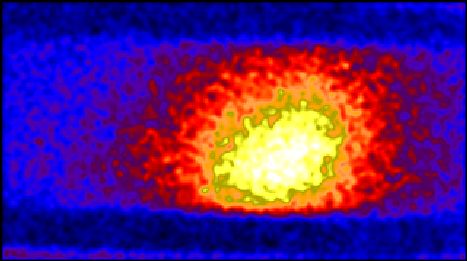
“As the Sun floods Comet Hyakutake with ultraviolet light gases in the coma scatter the radiation and fluoresce making the comet a bright source in the ultraviolet sky. The above image made using data from NASA's Extreme UltraViolet Explorer (EUVE) satellite, represents the intensity of the comet in this invisible high energy band in false color. The image is about 3/4 of a degree high and 2 degress wide and offers insights to the composition of this visitor from the distant solar system that can be obtained from the highest energy bands of the ultraviolet spectrum. The International Ultraviolet Explorer (IUE) satellite has also examined ultraviolet light from the comet and now reports the detection of many bands of molecular emission particularly those due to molecular carbon (C2), carbon monoxide (CO) and caron dioxide (C02) ions as well as indications of a rapid increase in the production of water (H20). Latest Comet Hyakutake images: JPL, Fayetteville Observer-Times, NASA's Night of the Comet, ICSTARS, Crni Vrh Obs., Cent. Mich U."
Copyright: Public domain
Upvote! Resteem! Comment! As you like it! Thank you for attention!
Congratulations @george-zagraid! You have completed some achievement on Steemit and have been rewarded with new badge(s) :
Click on any badge to view your own Board of Honor on SteemitBoard.
For more information about SteemitBoard, click here
If you no longer want to receive notifications, reply to this comment with the word
STOPCongratulations @george-zagraid! You have completed some achievement on Steemit and have been rewarded with new badge(s) :
Click on any badge to view your own Board of Honor on SteemitBoard.
For more information about SteemitBoard, click here
If you no longer want to receive notifications, reply to this comment with the word
STOP